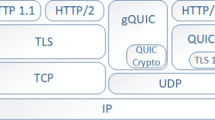Abstract
The Internet protocol (IP) was created as a connectionless network layer protocol that takes no attempt to distinguish between various application types. Hence, the integration of a wide range of telecommunication services over the Internet is the main reason behind the need for the provision of quality of service (QoS) guarantees to end users. In such multiservice networks, resources are managed based on service level agreements (SLA), acknowledging different types of traffic in terms of bandwidth requirements, delay and other QoS parameters. An SLA is the documented result of a negotiation between a customer and a service provider that defines service characteristics, responsibilities and priorities of every party. An SLA may include statements about tariffing and billing, service delivery, and compensations. This paper provides a short overview of some aspects of quality of service, and identifies main issues and problems of defining and managing an SLA, based on its current standardization stage.
Zusammenfassung
Das Internetprotokoll (IP) wurde als verbindungsloses Netzprotokoll völlig unabhängig von den verschiedenen Anwendungstypen entwickelt. Die Einführung verschiedener Telekommunikationsdienste im Internet ist der Hauptgrund für den Bedarf an benutzergarantieren Dienstegüten. In einem Multiservicenetz werden die Ressourcen mittels Service Level Agreements (SLA) gehandhabt und durch die verschiedenen Verkehrstypen in Bezug auf QoS-Parameter, wie zum Beispiel Bandbreite und Verzögerung zugewiesen. Durch Service Level Agreements werden Rechte und Pflichten zwischen dem Diensteanbieter und dem Dienstenutzer zusammengestellt und vertraglich fixiert. Gleichzeitig werden messbare Kriterien vereinbart und ein Rückkopplungsprozess bestimmt, um den Erfüllungsgrad der Qualität nachweisen zu können. Ein SLA kann Erklärungen über Tarifierung und Abrechnung, Lieferung und Entschädigung miteinschließen. Dieser Beitrag gibt einen kurzen Überblick über einige Aspekte des QoS und identifiziert Hauptfragen und -probleme bei Definition und Management eines SLA.
Similar content being viewed by others
References
Awduche, D. (2001): Multiprotocol lambda switching: combining MPLS traffic engineering control with optical crossconnects. IEEE Comm. Mag. 39 (3): 111–116.
Blake, S., Black, D., et al. (1998): An architecture for differentiated services. IETF RFC 2475.
Braden, R., Clark, D., Shenker, S., (1994): Integrated services in the Internet architecture: an overview. IETF RFC 1633.
Braden, R., Zhang, L., et al. (1997): Resource reservation protocol (RSVP) — Version 1: Functional specification. IETF RFC 2205.
Chao, H. J., Guo, X. (2002): Quality of service control in high-speed networks. New York: Wiley.
E.800 (1994): Terms and definitions related to quality of service and network performance including dependability. ITU-T recommendation.
E.801 (1996): Framework for service quality agreement. ITU-T recommendation.
E.860 (2002): Framework of a service level agreement. ITU-T recommendation.
Jamoussi, B., Andersson, L. (2002): Constraint-based LSP setup using LDP. IETF RFC 3212.
Jha, S., Hassan, M. (2002): Engineering Internet QoS. Boston London: Artec House.
Nahrstedt, K., Steinmetz, R. (1995): Resource management in networked multimedia systems. IEEE Comp. 28 (5): 52–63.
Marilly, E., Martinot, O., Betge-Brezetez, S., Delegue, G. (2002): Requirements for service level agreement management. In: Proc. of IEEE Workshop on IP-Operations and Management (IPOM 2002). Dallas, Texas, 57–62.
Räisänen, V. (2003): Implementing service quality in IP networks. Chichester: Wiley.
Rosen, E., Viswanathan, A., Callon, R. (2001): Multiprotocol label switching architecture. IETF RFC 3031.
SG 2, contribution 54 (2004): QoS handbook. ITU-T contribution.
Wang, Zh. (2001): Internet QoS, architectures and mechanisms for quality of service. San Francisco: Morgan Kaufmann Publishers.
Xiao, X., Ni, L. (1999): Internet QoS: A big picture. IEEE Network 13 (2): 8–18.
Author information
Authors and Affiliations
Corresponding author
Rights and permissions
About this article
Cite this article
Statovci-Halimi, B., Halimi, A. QoS management through service level agreements: a short overview. Elektrotech. Inftech. 121, 243–246 (2004). https://doi.org/10.1007/BF03055357
Published:
Issue Date:
DOI: https://doi.org/10.1007/BF03055357




